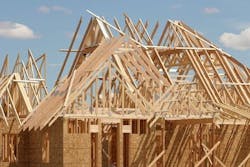June’s official new-home starts numbers — 23.9 percent higher than a year earlier — are worthy of note. Since 2010, monthly housing starts have risen and fallen, bumping along the bottom of the housing trough. This variability created genuine uncertainty about the timing of a home building recovery. But June’s starts figures show underlying strength that is of a different cloth. There is no $8,000 homebuyer tax credit pulling business forward and pushing up starts, as was the case in the spring of 2010. Nor are there any seasonal or weather-related anomalies pointing toward yet another temporary lift. In short, the ground under builders’ feet feels more solid. This is supported by a nice increase in the National Association of Home Builders’ Builder Confidence Index. But if we are now climbing back, there is a long way to go.
An extrapolation of June’s housing production puts us on pace to hit 760,000 new homes in 2012 — single family and multifamily combined. Demographic and household formation numbers suggest much higher real demand. Some economists estimate that pure demand — unencumbered by a familiar litany of obstacles that now plague the housing market’s machinery — would net annual new-home starts figures of 1.6 million. The gap between this pure demand and low production has rightly been the focus of housing recovery efforts. Obstacles to home buying are falling slowly, but some stubborn ones remain.
On the barrier-free side, low mortgage rates and rising rents are bringing more buyers out to new-home models. On the negative side, depressed home prices, a persistent overhang of foreclosed houses along with flawed appraisals and overly tough mortgage underwriting remain obstacles to growth. The last one — ‘overly tough mortgage underwriting’ — is something worth tackling quickly, particularly with the looming specter of new Dodd-Frank regulations coming down the pike.
The new law requires that banks evaluate a home buyer’s “ability to pay” high-quality, low-cost mortgages known as Qualified Mortgages or QM. The new standard for Qualified Mortgages is now being written by the Consumer Financial Protection Bureau. And many interested parties, including the National Association of Home Builders, are working hard to ensure that this new standard does not inhibit buyers from getting mortgages. It is tough enough right now to get a mortgage. So, it is crucial that government regulators, bankers and the industry are communicating effectively to get this right.
“It is critical that such reforms are implemented in a manner that causes minimum disruption to the mortgage lending process,” NAHB Chairman Barry Rutenberg recently cautioned the House Committee on Oversight and Government Reform. “New reforms should not limit consumer financing options, increase the cost of financing or reduce the availability of mortgage credit.”
We at Professional Builder could not agree more. Americans have shown continued interest in buying and owning homes. The demand for new homes is real. We need to keep focused on removing obstacles to homeownership. The new QM, when it emerges, should not impede the market further.
